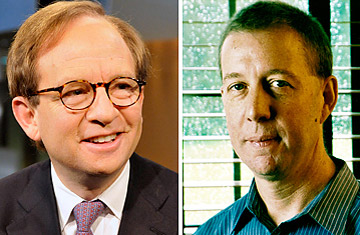
Steven Rattner, left, and Ron Bloom
A few weeks after Treasury Secretary Timothy Geithner tapped Wall Street financier Steven Rattner to try and save the U.S. auto industry, Rattner sat down for coffee at a nondescript café in Washington with the man he wanted to be his deputy, Ron Bloom. Both men had spent much of their careers in the universe of high finance, but they came from different planets. Thanks to the success of his dealmaking firm, Quadrangle, Rattner, 56, lives atop New York society in an apartment overlooking Central Park and the Metropolitan Museum of Art. Bloom, who turns 54 today, lived until recently in Pittsburgh and trained as an investment banker so he could help unions negotiate complicated deals, which he has done for the past 15 years as an assistant to the president of the United Steelworkers union.
So there was some understandable tension when the two men sized each other up in January over coffee at their first face-to-face meeting. When Rattner outlined the draconian marching orders Geithner had given him to try to save General Motors and Chrysler, Bloom paused and laid down a marker. He saw the job as a potential capstone in a career spent championing labor interests during years of industrial restructuring. He understood that the situation called for tough medicine for autoworkers. But I also want you to know, Bloom said, that I've dedicated my life to preserving as many American jobs as possible. Rattner, the titan of investment banking, said he wanted the same thing. (See 25 people to blame for the financial crisis.)
America has always debated the primary source of its wealth: capital or labor. And in a way that happens more frequently in literature than in life, Rattner and Bloom are neatly drawn avatars for the opposing sides of that argument. As such, they make a complementary team to resuscitate the moribund automakers. Out of money and out of options, GM and Chrysler can be saved from complete dissolution only by a government effort to reconcile management, workers and creditors to a much-diminished future. If Rattner and Bloom can find common ground, perhaps those dueling interests can too.
Bloom's objectives in undertaking this assignment are fairly easy to see. "He's a true believer, philosophically, with workers," says Gary Hubbard, spokesman for United Steelworkers. "That's a very fundamental part of his own makeup." When Bloom started working for unions after college during the financial downturn of the early 1980s, he concluded that they were not equipped to do the deals they needed to save their jobs. So after Harvard Business School, he set up a shop at the investment bank Lazard Frères that focused on counseling unions in leveraging their collective bargaining power to maximum effect. He pioneered the deals that took retirement and health benefits off company books and protected those benefits for workers.
Rattner's aims are less clear. He started as a reporter at the New York Times in the 1970s and left to begin a successful career as a media-business dealmaker on Wall Street. His lifestyle is the envy of many who have watched his career, which also got its start at Lazard Frères — he has the fancy cars, the Fifth Avenue apartment and homes in Westchester and on Martha's Vineyard. A major Democratic donor, Rattner's brains and ambition have propelled him to the top, but he has made enemies along the way. In a now famous New York magazine profile, his onetime Lazard Frères mentor, Felix Rohatyn (Bill Clinton's ambassador to France), accused Rattner of being a social climber averse to public service and cultural pursuits. Rattner now sits on the board of a variety of charities as well as the Metropolitan Museum of Art.
Whatever their goals, the two men are well positioned to restructure the auto industry. Rattner can tell management and bondholders what they have to live with. Over the course of the past three months, he has come to believe that the bondholders, who have thus far balked at taking GM stock for much of their debt, made a bad investment and should lose all their money, says one person familiar with the President's auto task force. Rattner also took the point in ousting GM chief Rick Wagoner over the weekend. Bloom, for his part, has taken day-to-day leadership in talks between Chrysler and Italian automaker Fiat. His union bona fides have made him the point man with the United Auto Workers union and its chief, Ron Gettelfinger. (See the 50 worst cars of all time.)
Although analysts credit the odd couple for playing tough with all sides, Rattner and Bloom's initial efforts are meeting with only moderate success. The stock market reacted negatively to the government's plan on Monday, with the S&P 500 dropping nearly 3.5% on fears that bankruptcy was inevitable for GM and Chrysler — a fear that the Administration did little to calm. President Obama, in his speech announcing the deal on Monday, tried to put a good face on things, laying out measures to save the companies, soften the blow to autoworkers and encourage auto sales with guaranteed warranties and car-buying tax incentives. But, he said, "these efforts, as essential as they are, are not going to make everything better overnight. There are jobs that won't be saved. There are plants that may not reopen."
The real test of Rattner and Bloom's collaboration is upcoming. Obama, in putting new conditions on any more billions being handed to Detroit, gave Chrysler 30 days to strike a partnership with Fiat and GM 60 days to avoid bankruptcy court. Rattner will have to browbeat intransigent bondholders. Bloom will have to force major benefit cuts on the unions. And both will have to sell management on a radical reordering of their companies, one in which both capital and labor take a serious hit in order to keep the machine running.
